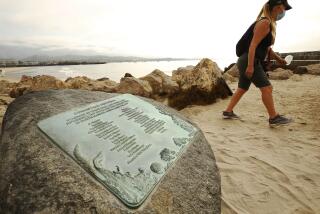Love on the Rocks: a Haunted Coast Story
California seems to have one of everything, including its own version of the Bermuda Triangle: a treacherous stretch of ocean off the Central Coast haunted by tales of lost ships and lost love.
Point Arguello, northwest of Santa Barbara, lies at the southern edge of what is known as the “Graveyard of the Pacific,” an area in which nearly 50 ships and hundreds of lives have been lost.
But the grim litany of wrecks has left a three-mile stretch of ocean bottom between Point Arguello and Point Pedernales virtually glistening like gold with the brass remnants of ships that lost their way.
The Yankee Blade, a side-wheeler steamer carrying 1,200 passengers to Panama in 1885, struck rocky Point Arguello. A crowd of unruly men pushed their way past women and children into lifeboats, only to have many of the boats capsize as about 415 drowned.
In 1911, four men were lost at sea when the Santa Rosa broke in half on the rocks. Then on Sept. 8, 1923, a navigation error sent nine Navy destroyers aground off the stormy point, sinking seven and killing 23 sailors in one of the worst peacetime disasters in U.S. naval history.
The 1930s brought the ill-fated voyage of the party ship Harvard and the Japanese freighter Nippon Maru, although no lives were lost in either mishap. Even the Point Arguello lighthouse keeper mysteriously disappeared in those days--probably stumbling along the cliffs and falling into the raging surf below--and helping cement the locale’s other nickname: “The Devil’s Jaw.”
Superstitious seamen and others have drawn many theories about the curse they believe has a grip on the spectacular stretch of coast where California seems to bend at its middle. Some believe the string of maritime disasters may have been born in the wake of one of California’s most renowned, and star-crossed, romances.
Point Arguello was named for a leading Spanish family of early California. And it was only after young Concepcion “Concha” Arguello’s true love died during an ocean voyage that the string of accidents began. The romance of the young Arguello and a Russian count, Nicolai Petrovich von Rezanov, has been told in poems, books, a full-length ballet and even a rock opera.
Story of a Count and a Teenager
The story begins in 1806, when the Russian empire pushed south from its Alaskan outpost. California’s Spanish rulers had banned all foreigners from entering the territory, but Rezanov was determined to obtain help for his starving countrymen in Sitka, Alaska.
The handsome, 42-year-old widower was able to make his way to San Francisco’s Presidio. But his attempts to establish trade with Spanish officials were unsuccessful until he began wooing Concepcion Arguello.
The 15-year-old was the daughter of the Spanish commandant and future California governor, Jose Dario Arguello, for whom Point Arguello was named.
Concepcion was taken with the aristocratic Rezanov. None of the histories seems to record whether he was also taken with the Spanish girl, or merely used her as a ploy to gain access to the trade his countrymen so desperately needed.
“Seeing that my situation was not improving, expecting every day that some misunderstanding would arise . . . I resolved to change my politeness for a serious tone,” Rezanov said in a cryptic official report.
Celebrating their betrothal, he gave her family two hand-carved ship chairs. In return, the Arguellos filled his ship with supplies for the hungry Russian outpost.
In 1807, Rezanov dropped off his goods in Alaska, then set off for Russia to obtain the czar’s permission to marry his betrothed. He died on the voyage, but no word of his fate was dispatched to Spanish California.
The faithful Concepcion awaited Rezanov’s return for 35 years in California, until word of his death finally reached her in 1842. She rejected numerous marriage proposals and devoted herself to nursing the sick and teaching Indian and Spanish children.
In 1851 she entered a convent, becoming the first Californian to take the vows of a Dominican nun. Six years after taking her final vows under the religious name Maria Dominica, she died at 67.
In the years since, many have wondered whether the misfortune that attached itself to Concepcion had somehow come to hover over the point of land that bears the Arguello name.
When the Navy convoy ran aground 78 years ago, the romantically and mystically inclined could not help but renew such speculation. How else to explain the disastrous fate of the ships convoying that late summer day on a speed test from San Francisco to San Diego?
At the head of the column was the Delphy, under Lt. Cmdr. Donald D.T. Hunter and carrying Capt. Edward H. Watson, who was in command of the 14 destroyers. Behind the Delphy came the S.P. Lee, the Young, the Woodbury, the Nicholas, the Farragut, the Fuller, the Percival, the Somers, the Chauncey, the Kennedy, the Paul Hamilton, the Stoddert and the Thompson.
By nightfall, as fog thickened and the sea grew rough, the officers were unable to see landmarks and stars. Sonar had not yet been invented, and plotting by compass and speed, the officers calculated they were south of treacherous Point Arguello and Point Conception (named for the Immaculate Conception, not Concepcion) and in position to turn left into the Santa Barbara Channel.
At that moment, the flagship Delphy received a signal from a Navy radio station on Point Arguello, indicating it was still north of the landmark. But radio compass bearings were relatively new navigational aids at the time and not trusted by veteran mariners.
Also, the airwaves that night were confused with messages about another wreck--of the mail ship Cuba, 30 miles south on San Miguel Island.
The naval squadron’s officers conferred and decided they were correct about their position. Just before 9 p.m., the Delphy made a hard left turn to destruction--three miles north of the Point Arguello lighthouse. In a grimly disastrous procession, the other destroyers followed.
The Delphy went down and the S.P. Lee, second in the formation, was stuck fast on the reef. The third ship to go down was the Young, commanded by William Loundes Calhoun, a great-grandson of John C. Calhoun, who served as vice president under John Quincy Adams and Andrew Jackson.
“I was starting for the bridge when I felt a slight trembling,” the captain told a court of inquiry. “I dropped everything and went on the run. I reached the bridge in time to be sprawled by a terrific knock. I thought we’d been rammed.”
The Young grazed the Lee and then smashed into the rocky shelf before capsizing. Nineteen crewmen were trapped in their quarters below deck. Three others were lost at sea on a raft, while another drowned after being blinded by shattered glass. A cocker spaniel named Doctor, the mascot of the Young, went down with his ship.
2 Officers Guilty at Court-Martial
About 600 survivors, mostly oil soaked, bruised and cut, huddled on the rocky shore, wrapped in blankets brought by townsfolk from nearby Lompoc.
Watson and Hunter were found guilty at a court-martial of “culpable inefficiency and negligence.” The punishment was loss of seniority for promotion.
Others were awarded medals for “heroic bravery and gallantry” during the rescue, including a 15-year-old seaman whose father lied about the boy’s age at enlistment.
Casey Bass was recognized for helping other sailors aboard a lifeboat.
In 1975, several reservists built a monument near the site of the groundings, on property where Vandenberg Air Force Base now stands.
Almost 61 years after the disaster, in 1984, a scuba diver found an 18-karat gold signet ring crowned with the initials W.L.C. and the year 1906. Engraved inside was a simple inscription: William Loundes Calhoun, U.S. Navy.
Although Calhoun had died in 1963, the diver returned the ring to his family.
But another ring, more valuable because it once was worn by his famous ancestor, went down with the ship and was never recovered--yet another loss off the storied and treacherous point.
More to Read
Sign up for Essential California
The most important California stories and recommendations in your inbox every morning.
You may occasionally receive promotional content from the Los Angeles Times.










